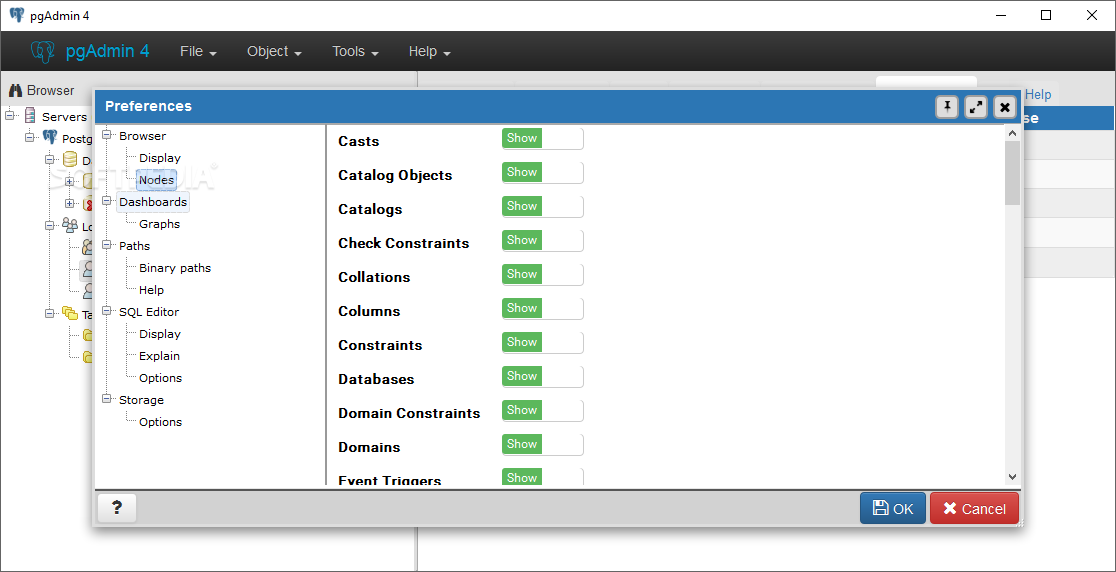

- #Download pgadmin 4 how to
- #Download pgadmin 4 mac os
- #Download pgadmin 4 install
- #Download pgadmin 4 64 Bit
Firewall-cmd -permanent -add-service=httpĬonsider disabling SELinux permanently for pgAdmin 4 to work properly. Set up the firewall so that we can access pgAdmin 4 from external machines. Output: NOTE: Configuring authentication for SERVER mode.Įnter the email address and password to use for the initial pgAdmin user account: Python /usr/lib/python2.7/site-packages/pgadmin4-web/setup.py Run the following command to create a user account for the pgAdmin 4 web interface. Chown -R apache:apache /var/lib/pgadmin4/*Ĭhown -R apache:apache /var/log/pgadmin4/* STORAGE_DIR = '/var/lib/pgadmin4/storage'Ĭhange permissions of directories so that Apache can write data into it. pgAdmin 4 (4.23) Version : 4.23: Platform : WindowsVendor : The pgAdmin Development Team: Architecture : 32-bit: Download Path -Silent Installation Switch - Silent Uninstallation Switch -Disclaimer: This webpage is intended to provide you information about patch announcement for certain specific software products. SESSION_DB_PATH = '/var/lib/pgadmin4/sessions' SQLITE_PATH = '/var/lib/pgadmin4/pgadmin4.db' LOG_FILE = '/var/log/pgadmin4/pgadmin4.log'
#Download pgadmin 4 64 Bit
Vi /usr/lib/python2.7/site-packages/pgadmin4-web/config_local.py pgAdmin is available for 64 bit Windows 7 SP1 (desktop) or 2008R2 (server) and above. Mkdir /var/log/pgadmin4/Ĭreate/Edit config_local.py file. Cp /etc/httpd/conf.d/ /etc/httpd/conf.d/nfĬreate a pgAdmin log and data directories. Advertisement DOWNLOAD LOCATIONS FOR: pgAdmin 4 v5.7. We would need to do a few configuration changes prior to accessing the pgAdmin 4.Ĭopy the pgAdmin 4 sample configuration. pgAdmin 4 v5.7 (141MB) Free graphical administration platform for the PostgreSQL database. Systemctl enable httpd Configure pgAdmin 4
#Download pgadmin 4 install
Once you have PostgreSQL repository configured on your system, run the following command to install pgAdmin 4. If not, add the PostgreSQL repository using the below command. PgAdmin 4 is available in PostgreSQL repository and your system should have the PostgreSQL repository by now if you have already completed the installation of PostgreSQL. We would need to enable the EPEL repository to download dependent packages for pgAdmin. Open a web browser and go to the following URL to access the pgAdmin 4 interface. Consider disabling SELinux permanently for pgAdmin 4 to work properly. Firewall-cmd -permanent -add-servicehttp firewall-cmd -reload SELinux.
#Download pgadmin 4 how to
Otherwise, follow the post: How To Install PostgreSQL 11 / 10 on CentOS 7 / RHEL 7. Set up the firewall so that we can access pgAdmin 4 from external machines. This post assumes that you already have PostgreSQL 9.2 and above installed on your system. In this guide, we will install pgAdmin 4 on CentOS 7 / RHEL 7 & Fedora 29 / Fedora 28 as a web application ( server deployment). Video how to download pgadmin 4 mac - Nghe nhc remix, nhc cover hay ht - Nghe Nhc Hay l ni chia s nhng video nhc Remix, nhc cover hay nht. The server connection setups I had in previous versions are all kept when starting the new version as well. What I do is just download the installer (see here) and run it. Now, have just upgraded to 4.22 version (mai/2020). When the runtime is launched from system-tray, it runs the pgAdmin server and launches a web browser to render the user interface. In Windows, I have been using and upgrading pgAdmin 4 since version 3.1. In desktop deployment (desktop application), it is deployed to run in desktop mode by utilizing the desktop runtime to host the application. In server deployment (web application), it is deployed as a web application behind a web server running as a reverse proxy or using the WSGI interface. PgAdmin can be run as a web or desktop application.
#Download pgadmin 4 mac os
It can be installed on multiple OS platforms such as Linux, Unix, Mac OS X, and Windows to manager PostgreSQL 9.2 and above.

PgAdmin is a free and open source management tool for PostgreSQL and derivative relation databases such as EDB Advanced Server.


 0 kommentar(er)
0 kommentar(er)
